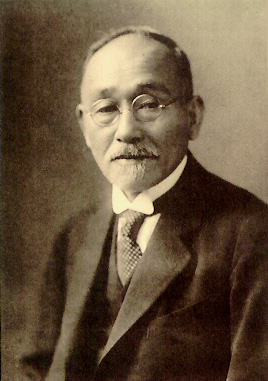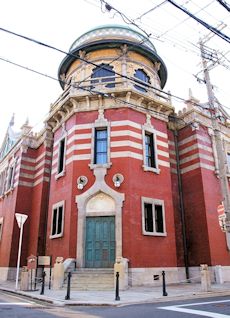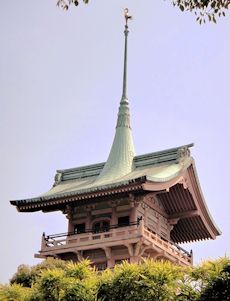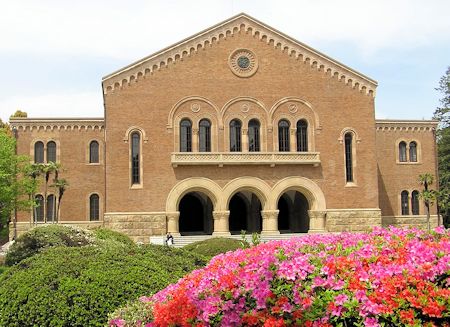|
Chuta Ito and Kyoto
 I would like to say that I decided to write the relationship between Chuta
Ito and Kyoto when I was in the precincts of Nishi-Honganj Temple (written
in the previous chapter) and remembered Tsukiji-Honganji Temple of its
sect, designed and built by Chuta. But it is not true. This story is what
I had deliberately planned from before. I would like to say that I decided to write the relationship between Chuta
Ito and Kyoto when I was in the precincts of Nishi-Honganj Temple (written
in the previous chapter) and remembered Tsukiji-Honganji Temple of its
sect, designed and built by Chuta. But it is not true. This story is what
I had deliberately planned from before.
I am such a man who wants to show off his knowledge on Chuta using everything
as an excuse to talk about Chuta. Though I honestly feel to wander off
this travelogue here, please allow me for another couple of minutes.
I noticed the blog "The Second Kyotoism" which features several
constructions Chuta Ito involved in.
This article is "not unrelated" to my novel "The Auditorium
Where Monsters Live", and also it should be helpful to introduce Dr.
Ito further for the self-proclaimed follower to him.
Therefore I am going to write my thought on Chuta and Kyoto mostly by the
blog's help.
First of all, look at the following two buildings. They appear in every
introduction of Chuta's design. (Why didn't I visit either of them this
time?)
The pictures are from the blog.
 |
|
 |
|
|
|
Mission Hall
of Nishi-Honganji, 1912 |
|
Gion-kaku Tower
1927 |
Mission Hall of Nishi-Honganj (formerly, Life-Insurance Company of Believers
of Shinshu Sect) is an innovative building darely with a breath of fresh
air from Asian architectural atmosphere during the days only with Western-style
buildings from Meiji to Taisho period.
Gion-kaku Tower has a hoko-like (halberd-like) long stick on top which
you see during the Gion Festival. So, the tower is quite different from
the total appearance of elaborate and scenic Higashiyama. It is truly because
of Chuta! (How did Kihachiro Okura, the owner, feel?)
Heian Shrine
Heian Shrine was also designed by Chuta. His first work in the middle of
his 20s! This work is certainly with a story behind it.
Chuta was studying Japanese architecture at the graduate school of Tokyo
Imperial University in Meiji 26 (1893), where his teacher was Kiyoyoshi
Kiko.
Meanwhile in Kyoto, the big event was planned to be held two years later
in Meiji 28 (1895). It was "The 4th National Industrial Exhibition"
and "The 1100th Anniversary of the Transfer of the Capital to Heian-kyo".
And for that reason, the restoration plan of Imperial Palace came up as
its special feature. One of the representatives of this project was Kiko,
who recommended Chuta Ito. Surprisingly thanks to him, Chuta was selected
and appointed as an architectural engineer of the Memorial Hall.
Putting that aside, Chuta was assertive since then. On the other hand,
the project scale was reduced to 5/8 compared to the original plan due
to the limited budget. In the result, he seemed unsatisfied with this job.
The name of Heian Shrine itself was at first called "The Memorial
Hall of Transfer of the Capital to Heian-kyo", and so was going to
be built just as the imitative Imperial Hall. But on the way of construction,
its name was changed to "Heian Shrine" dedicated to Emperor Kammu.
Later the 121st Emperor Komei, the last emperor while Kyoto was the capital,
was added to the deity of the shrine in Showa 15 (1940).
The shrine was completed in Meiji 28 (1895).
Though it is said to have been designed jointly by Kiyoyoshi Kiko, Chuta
Ito and Iwajiro Sasaki, actually with Kiko, as an advisor of honorary post,
Ito took charge of theoretical design and Sasaki of technical practice.
In January, Showa 51 (1976), 9 buildings including the Main Hall and Inner
Hall of Worship were set on fire and went up in flames. The present shrine
buildings were reconstructed in Showa 54 (1979).
There are several joint constructions of Ito and Sasaki as follows. It
is the evidence of how well they got alongl. ..... Hokoku Mausoleum (1898),
Miyazaki Shrine (1907), The Old Chokokan (1907), The Residence of Soichiro
Asano (1909) and The Main Hall of Zojoji Temple (1925).
In any case, in the result that Chuta was involved in the construction of Heian Shrine as a planner, designer and director, he got connections with such people like bureaucrats and temple carpenters, and so it seems he was able to make a good start for the road to a giant in the architectural world.
Encounter with Kozui Otani
Chuta Ito made a travel from Asia through the Middle East, Europe and North
America for three and a half years from Meiji 35 (1902).
At that time, he encountered a certain student, a member of Otani Expedition
sponsored by Kozui Otani, around the area from Kishu to Unnan in China.
After the travel, he visited Kozui, the Abbot of the Nishi-Honganji sub-sect
Jodo-Shinshu Buddhism, at Nishi-Honganji Temple.
They got along well, and Kozui asked Chuta to design Dairen Branch Temple
(China) and Chinzei Branch Temple (Fukuoka Prefecture). However, both of
them were not realized because of the opposition of the supporting members
who adopted old-fashoned temple architects. The idea of the two might have
been too innovative then.
But this was the chance Kozui became a financial sponsor of Chuta.
The famous works of Chuta for Kozui are; The Second House "Niraku-so"
at Mt. Kobe-Roko (1909, burned down in 1932), Mission Hall of Nishi-Honganji
(1912).
Furthermore, the architecture most famous for Nishi-Honganji is Tsukiji-Honganji
Temple in Tokyo in the old-Indian style (1934). This temple is surely Chuta's
work by the request of Kozui Otani.
At first it seemed to be strange to anybody, but now it is the most important
base of the sub-sect of Jodo-Shinshu Buddhism in the east.
Even so, Chuta is said to have disliked nosy believers and expressed dissatisfaction
of the workmanship all through. ("Chuta Ito, an architect" written
by Hideto Kishida).

Kihachiro Okura and Chuta Ito
I referred to Kihachiro Okura as another important financial sponsor of
Chuta Ito in my novel "The Auditorium Where Monsters Live".
It is Kanematsu Auditorium of Hitotsubashi University located in Kunitachi
in the suburbs of Tokyo.
Chuta was concerned with everything of the construction from design to building, and he commuted there on a local train in such a slow speed at that time far from Hongo, center of Metropolitan Tokyo, in order to lead the construction to the completion himself.
It is his only building of Western style, which has numerous monsters both
inside and outside. Especially most of the inside monsters were his own
works. He kneaded clay to make them himself.
This auditorium would never have appeared without Kihachiro Okura. Tokyo
Commercial College (presently Hitotsubashi University) was promoted to
a National college a couple of years before all right, but it was actually
still a commercial and economic college, apt to be avoided by the Government.
It decided to move the campus from Kanda, the center of Tokyo, far west
to Musashino wilderness just after all the school buildings were burned
down by the Great Kanto Earthquake.
Who would build the auditorium in the Kunitachi new campus?
In fact at the time, it had no point of contact at all with Dr. Chuta Ito,
a famous professor at the Engineering Faculty of Tokyo Imperial University.
Besides, the budget of the Government to build it in the remote campus
was extremely severe just after the big earthquake.
In such a situation, luckily Kanematsu Company in Kobe proposed to donate
the whole expense of the construction which was nearly five times more
than the Government budget. Thanks to this charity, the college came to
the extraordinary idea that the architect to help embody its traditional
spirit would be no other person than Dr. Chuta Ito.
Kihachiro Okura realized this dream. His very best friend was Eiichi Shibusawa,
the birth and foster parent of the college. Shibusawa had the same dream
with the college people. So he gave an earnest request to Okura, who sincerely
understood it and opened up a road to Chuta Ito.
Leaving the detail to my novel, Chuta became busy.
While seeing his life in the college's thorny-path history and its hardship
and struggle against the Government, he accepted its plan himself though
fully occupied. After one year and a half, he finally realized Kanematsu
Auditorium in the Romanesque style.
During those days, most of the auditoriums of colleges and universities
were built in the Gothic style, generally called "College Gothic"
just like Yasuda Auditorium of Tokyo Imperial University, Okuma Auditorium
of Waseda University and Mita Library of Keio Gijuku University.
Why did Dr. Ito darely avoid the "College Gothic" style and select
the one-generation-old "Romanesque" style with several problems
in the style itself? This is one of the crucial mysteries to have to be
solved when talking about Dr. Ito and the construction of Kanematsu Auditorium.
Sorry for a long talk, but I absolutely have to say the construction of
Kanematsu Auditorium by Dr. Ito was never realized like a dream without
Kanematsu Company, Eiichi Shibusawa and Kihachiro Okura, not to mention
the professors and the people involved including the president Zensaku
Sano.

The other constructions Chuta involved in by his request are Okura-Shukokan
Museum, Gionkaku Tower, Kyoto Residence of Kihachiro Okura, etc.
 |
|
| Okura Museum |
|